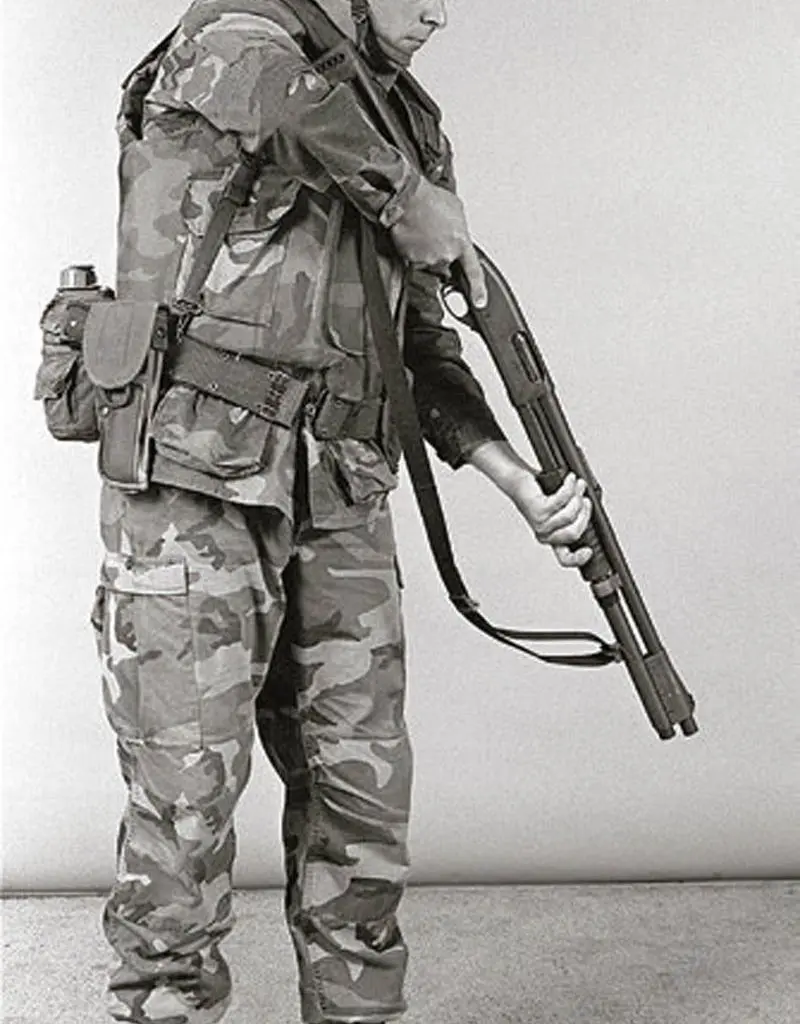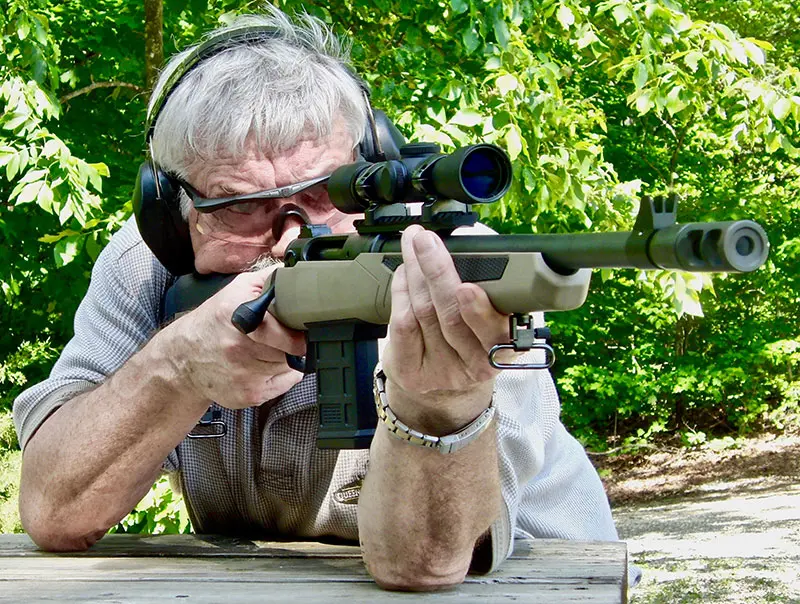
I’VE been fascinated by U.S. military trench guns since I bought my first one—a much-used Winchester Model 97 Trench Model— more than 40 years ago.
For most of us, the Model 97 is the most recognizable Trench Gun, which is as it should be. It saw service in World War I, World War II, Korea, a bit in Vietnam, and reportedly in the First Gulf War. It has also been a staple in films.
But a lot of veterans, especially of the USMC, thought the Model 12 was the ultimate U.S. Trench Gun. It helped clear Japanese bunkers in World War II and was carried by point men in Vietnam. I like them both, as well as the other U.S. military riot and trench models.
In World War I, the Germans didn’t like them and complained via the Swiss that they didn’t adhere to the “rules of war” and threatened to execute U.S. troops caught carrying one. The U.S. Judge Advocate General sent a reply showing they did not violate any rules of war, and other U.S. authorities made it clear that if any U.S. troops were executed, an equal number of German troops would be.
General John Pershing, who had seen the effectiveness of Model 97 riot guns when he served in the Philippines, supposedly provided a lot of the impetus for the shotgun’s adoption by the American Expeditionary Force. But the Ordnance Department was not satisfied with the standard riot model as previously used. They wanted the capability of attaching a sling and a bayonet.
The result for the Model 97 was the well-known ventilated handguard with front sling swivel and bayonet mount. A 1917 Enfield bayonet was used since those were in production by Winchester for the 1917 rifle. The handguard was deemed necessary so the shotgun could be grasped for a bayonet thrust right after firing without burning the hand. I always felt it gave the Model 97 an especially martial aspect, and I think others have agreed over the last 95 years.
One other Trench Gun, the Remington Model 10, was adopted in World War I, but it used a wooden handguard rather than the ventilated steel one of the Model 97 Winchester.
During World War II, in addition to the two Winchester Trench Guns on hand and produced during the war, the Ordnance Department acquired more trench guns from Stevens—the Model 520-30 and 620-A—and a small number of Ithaca 37 Trench Guns. All of these shotguns acquired as Trench Guns were also obtained in Riot Gun configuration without the ventilated handguard and bayonet lug. Normally the Ordnance Department referred to all combat shotguns acquired as riot models and did not differentiate.

After World War II, there were enough Trench and Riot Shotguns in armories to fulfill most requirements. In fact, many World War II-era Trench Guns were issued in Vietnam, especially the Model 12s, as well as riot models. Many additional riot guns were acquired for use in Vietnam, including the Ithaca 37 and Stevens 77E.
Although U.S. armed forces would primarily purchase riot models (i.e., no handguard or bayonet lug) in the future, there were exceptions. For example, circa 1967, Winchester made a Trench Gun version of the Model 1200. Oddly enough, the bayonet lug was still designed to take the M1917 bayonet.
Model 1200 Trench Guns were ordered for the U.S. Army circa 1968 and at least some appear to have ended up with National Guard units for use during the urban unrest of the time. Some of these National Guard guns, which appear unused, were later sold off and entered the civilian market. Others saw service in Iraq and Afghanistan when Guard units were deployed.

For decades, the most popular police shotgun has been the Remington 870. During the Vietnam War, the 870 was also adopted for military usage. The USMC has always stressed the use of the bayonet and still found the ability to mount a bayonet on a shotgun desirable. Designated the “Model 870, Mark 1” when adopted in 1969, this shotgun had a 21-inch barrel and an extended magazine that held seven rounds. It also had a bayonet lug capable of taking the M7 bayonet then in use on the M16 rifle.
Other branches did not see a requirement for the bayonet on a shotgun. Some didn’t even see its desirability on a rifle! Remington 870s without bayonet lugs were also acquired. Later the Mossberg 500/590 was adopted, and the USMC adopted the Benelli M1014, neither of which took a bayonet. But at least some Marine units continued to use the 870, Mark 1 into the 21st century.
The shotgun with bayonet mounted has a lot of utility, especially in crowd control. Less-lethal munitions may be fired from the shotgun to disperse a crowd, while troops advancing with fixed bayonets can encourage any stragglers to move on down the line. Troops firing less-lethal munitions may also have lethal loads on their person, but care must be taken where they are carried to avoid mixing the two types. Another option is the M26 Modular Accessory Shotgun System, which mounts a shotgun under the M4.
A shotgun mounting a bayonet is also useful for MPs in controlling prisoners. For people control, shotguns mounting bayonets are hard to beat. Some Winchester Model 1200 Trench Guns, mostly in the hands of National Guard troops, and some USMC 870, Mark 1s have seen service in Iraq and Afghanistan, but both are aging.
However, Mossberg does produce the Model 590A1 with bayonet lug for military use. The lug takes the M9 bayonet. I also understand that there is at least a military bid spec for this shotgun with a heat shield.
I like the idea of the shotgun with the capability of taking a bayonet for many reasons. I think it has special applicability for anyone acquiring a “preparedness” weapon for natural disasters or other bad times. A shotgun is very intimidating to potential looters, home invaders, and other undesirables. Add a bayonet to that shotgun and it becomes even more threatening.
Among its other advantages, a shotgun mounting a bayonet greatly discourages anyone contemplating an attempt to disarm you. If you can’t shoot them off, you can cut and slash them off! For the civilian market, Mossberg offers the 590A1 with bayonet lug, along with the M9 bayonet. That’s a great preparedness combo.
I’ve always been especially interested in U.S. military shotguns. As a reresult, I was very anxious to test the closest thing to a modern Trench Gun, the 590A1 with bayonet.
I put 50 rounds through it, about half with bayonet mounted and half without. It was reliable, shot good patterns, and its ghost ring sights were a real aid to accuracy, especially with the slugs I fired. A short Picatinny rail offers the ability to mount a compact red dot if so desired. The barrel is ported, which seems to help with recoil a bit. The thick recoil pad helps too.
I’ll discuss the 590A1 and more in an upcoming column on the advantages of the bayonet on long guns for disaster and bad times preparedness.






